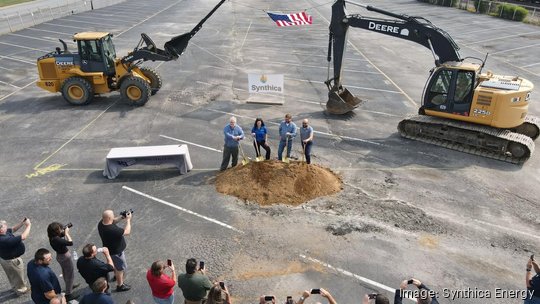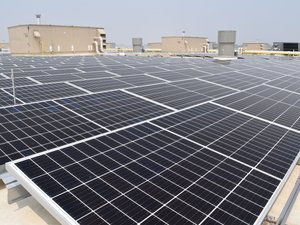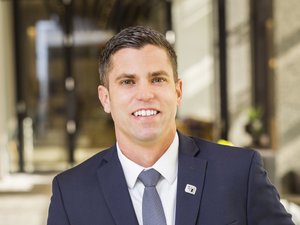
A Blue Ash company is leveraging a large investment from Goldman Sachs to advance its goal of bringing renewable energy facilities to cities across the United States.
Synthica Energy announced an equity investment from Goldman Sachs Asset Management’s Infrastructure Business on Aug. 7. The investment will immediately accelerate Synthica’s developments in Texas, Georgia, Kentucky and Louisiana and allow further expansion into Florida, Illinois, Missouri, New York and Pennsylvania in the coming years. CEO Sam Schutte said the backing allows Synthica to go on the attack in those regions.
“It’s all about speed-to-market," he said. "That’s the bottom line. That’s what we gain from our partnership with Goldman Sachs – velocity.”
Cincinnati-based law firm Taft Stettinius & Hollister acted as legal counsel to Synthica on the investment. The financial terms of the deal were not disclosed.
Synthica Energy was founded in 2017 on the premise that the U.S. had barely scratched the surface of waste-to-energy conversion. Schutte believed continuing to lag in the field was tantamount to throwing away both fuel and money. Six years later, large companies are looking to live up to their “net-zero” pledges, and according Schutte, they can save money – and create jobs – in the process.
“We are on the front end of a movement,” he said.
Synthica develops large-scale methane conversion facilities that turn organic waste into renewable natural gas (RNG) using anaerobic digestion. The firm contracts with major food, beverage and industrial manufacturers to receive a continuous supply of feedstock, giving the manufacturers a nearby, low-cast alternative to landfills. The feedstock includes food scraps, brewer’s yeast, paper, wood, and more –“excess pizza dough that hit the floor of the pizza factory one day,” for example, according to Schutte.
Food scraps might seem mundane, but they add up: The average American home wastes 250 pounds of food every year, and food waste from industrial sources just in Ohio tops eight million tons annually, Schutte told the Business Courier.
“How many breweries were there in Cincinnati 10 years ago, and how many are there now?” Schutte posed. “That’s millions of tons of high-strength organic waste that can’t go into the sewers without expensive processing. That’s not renewable. The sewer treatment plant has to expend electricity or send it far distances. So part of this is people realizing, ‘Wow, if I’ve got pallets of expired french fries, maybe I can try bioconversion.’”
Schutte and co-founder Grant Gibson will continue to lead the company. Mark Weidman, former CEO of Wheelabrator Technologies Inc., will serve as executive chairman.
The news surfaced a week after Synthica broke ground on its first RNG facility. Located on Vine Street in St. Bernard, the location is owned by Hamilton RNG Holdings, a joint venture between Synthica and a subsidiary of UGI Corporation, a King of Prussia, Pa.-based utility company.
The St. Bernard facility is expected to divert around 200,000 tons of waste from landfills and sewers and generate around 250,000 million British thermal units of RNG every year staring in 2024. That’s the energy equivalent of about 2 million gallons of gasoline, or enough energy to power around 2,314 homes for a year, according to U.S. Environmental Protection Agency calculations.
The facility will employee around 20 people to refine the RNG. Synthica has long-term agreements in place to manage waste at the facility from multiple local manufacturers.
“That facility is going to process a million pounds per day of organic products in the Cincinnati market and turn it into organic fuel that will be injected into Duke Energy pipelines and purchased from customers that want to run their facilities on renewable energy sources,” Schutte said.
The renewable energy produced by anaerobic digestion is a one-to-one replacement molecule with the natural gas that’s drilled and fracked out of the ground (and lost in large sums from fugitive pipeline emissions) The RNG from anaerobic digestion facilities is deemed a net-negative greenhouse gas, however, because the process diverts waste from landfills, capturing and removing methane that would otherwise leak into the atmosphere. The facilities’ urban locations also keep manufacturers from having to lug the waste to far-flung disposal sites, saving on transportation-related emissions and costs.
The RNG produced from the facilities is a constant, rather than intermittent, source of renewable energy. Used as vehicle fuel, it could result in greenhouse gas emissions reductions of up to 400%, according to research from the U.S. Department of Energy.
“Once we break the materials down into the elemental components and release their energy, what we end up with is a really rich fertilizer solid that we can mix into topsoil for a ton of different, beneficial uses – for instance, to reclaim strip mines,” Schute said. “It also produces a lot of water, which we treat ourselves back to normal industrial wastewater standards.”
Synthica’s urban focus required built-in odor-elimination measures. The company's anaerobic digestion process occurs in sealed, oxygen-free vessels, and the feedstock does not include human waste from sewage treatment plants. Synthica avoids storing feedstock in open lagoons or staging areas. It pumps organic liquids straight from the delivery tanks into cold digesters and stores organic solids at indoor receiving buildings that use high-powered fans to create negative air pressure, ensuring air comes in from outside but cannot escape. Biofilters prevent the release of odors into the environment.
Schutte and his partners created Synthica drawing on their backgrounds consulting with some of the largest local bakeries and organic chemical producers.
“We identified a big market gap in Cincinnati,” Schutte said, “where there a ton of food producers, flavoring companies, breweries, even whiskey distilleries – tons of that type of manufacturer but no good organic waste outlets. That meant customers were driving many hours to find sustainable outlets. That’s where we saw an opportunity.”
Despite widespread use of anaerobic digestion facilities around the world – Germany alone has 9,000 large-scale facilities; China has millions more small-scale digesters – the U.S. has astonishingly few. Just 1,500 facilities exist stateside, most on farms for the processing of animal waste. There isn't an anaerobic digestion facility within 60 miles of Cincinnati right now. The St. Bernard location won't just change that, according to Schutte; it will put Cincinnati "on the map as a leading hub for renewable energy."
Synthica currently has anaerobic digestion facilities permitted in 10 other cities, each able to accept at least 300,000 tons of feedstock. One facility between Louisville and Elizabethtown, Ky., will be able to accept up to 400,000 tons. Five of the projects have 2024 groundbreaking dates.
“Part of the reason it took so much time in effort in Cincinnati is we had to find the right approach,” Schutte said. “We went down a lot of blind alleys on things we shouldn’t have spent time on. In the new markets, we’re working so much faster.”
The company has ten members of the executive team working out of its Blue Ash office. Schutte said they are looking to “drastically” build out the c-suite team in Cincinnati and move into new offices soon.
He expects the demand for anaerobic digestion to grow as manufacturers and local governments become more aware of the cost savings and environmental benefits. Particularly in Cincinnati, he expects the St. Bernard facility to entice more companies to relocate – including some of the largest breweries in the country, who have been deterred from the region, according to Schutte, due to the lack of an anaerobic digestion facility.
“That’s another expansion opportunity for us, because there’s all these new factories opening and growing,” he said. “So as jobs and manufacturing come into the region, a good number of them will want to work with us, and it becomes an attractor to the region.”







